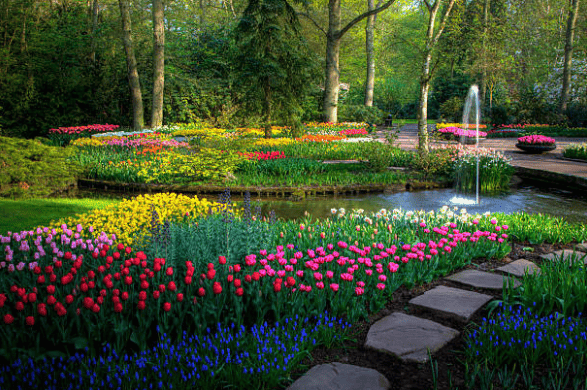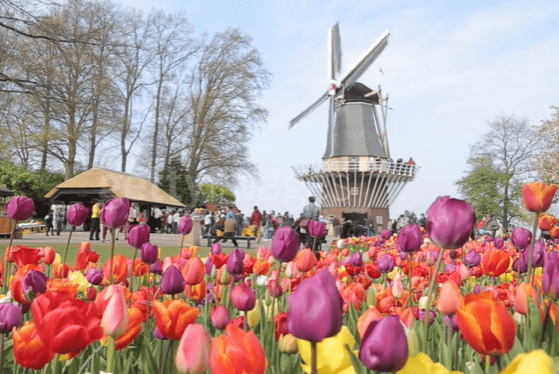One of the main tourist destinations when traveling to the Netherlands is visiting its famous flower gardens. Keukenhof, located in the small town of Lisse, is actually the largest flower garden in the world. Getting to Keukenhof is easy; you can simply take a bus from Schiphol International Airport.

As winter transitions into spring, vibrant daffodil blooms start to appear across the expansive flower fields in the Netherlands. This stunning golden carpet marks the beginning of the flower season, with colorful tulips following closely behind. By the end of March, the gates of Keukenhof open for another season, welcoming over a million visitors.
In this article, we will discuss the history of these extraordinary gardens, highlight some interesting spots you shouldn’t miss, and offer practical tips for anyone wishing to visit the world-renowned Keukenhof Garden. Our insights come from our experience organizing high-quality private tours that take guests from Amsterdam to the gardens.
Tulips have long been recognized as a symbol of the Netherlands, largely due to the presence of Keukenhof. Approximately 7 million flowers are planted in this 32-hectare garden, which features not only tulips but also various other flowers such as daffodils, hyacinths, and cherry blossoms.

This beautiful spring flower garden is located in southern Netherlands, specifically in the small town of Lisse, southwest of Amsterdam. Getting to Keukenhof is straightforward; you can use public transportation from Amsterdam, Rotterdam, or The Hague. If you’re coming from Schiphol International Airport, you can go directly to Keukenhof.
Outside Schiphol Airport, there are minivans that sell tickets to Keukenhof. Tickets are priced at 24 euros (around 380,000 IDR), which includes round-trip transportation from Schiphol to Keukenhof and entrance fees. The journey takes about 1.5 hours.
I visited Keukenhof last spring, specifically in May. I arrived at Keukenhof around 1 PM. Since I came from the airport with my luggage, I had to store it in a locker by the entrance. The lockers can be rented for 1 euro (about 15,900 IDR).

As soon as you enter Keukenhof, you are greeted by a stunning carpet of colorful tulips within the vast garden. These vibrant tulips bloom beneath the lush trees, growing alongside small rivers that flow throughout the park. In addition to tulips, Keukenhof features several pavilions showcasing various plants. Flowers are planted in different themed gardens, such as the Historical Garden, Water Garden, and Japanese Garden, which is designed to resemble Japanese flower gardens complete with blooming cherry blossoms. Wow!
Visitors can also enjoy the beauty of the garden by taking a speedboat ride through the canals. Meanwhile, at the back of the garden, there are vast fields of tulips that resemble rice paddies. Guests can observe these tulip fields from the top of a windmill, which are traditional electricity-generating structures found easily in the Dutch countryside, including the fields. Tourists can enter the windmill for free.

Keukenhof is not just a beautiful spring flower garden; it is actually a flower exhibition where plant seed entrepreneurs from the Netherlands and other European countries can showcase their creations and meet potential buyers and importers. The Netherlands is now known as the largest flower exporter in the world. Since tulips only bloom for two months—from mid-March to mid-May—Keukenhof is only open during this time.

In 2018, Keukenhof will be open from March 22 to May 13. Don’t miss the flower parade on April 21, 2018. If you want to visit Keukenhof, you can purchase tickets online or at Schiphol International Airport, as I did. However, be prepared to queue since this flower festival is highly popular among tourists. I myself had to wait nearly an hour to get my ticket.

аккаунт для рекламы заработок на аккаунтах
маркетплейс аккаунтов перепродажа аккаунтов
перепродажа аккаунтов https://magazin-akkauntov-online.ru/
аккаунты с балансом маркетплейс для реселлеров
продажа аккаунтов соцсетей продажа аккаунтов соцсетей
профиль с подписчиками продажа аккаунтов
магазин аккаунтов продать аккаунт
Find Accounts for Sale Verified Accounts for Sale
Verified Accounts for Sale Ready-Made Accounts for Sale
Account Trading Service Social media account marketplace
Guaranteed Accounts Accounts market
Account Market Accounts for Sale
Profitable Account Sales Profitable Account Sales
Account marketplace Website for Buying Accounts
Find Accounts for Sale Sell Account
Verified Accounts for Sale Verified Accounts for Sale
Marketplace for Ready-Made Accounts Find Accounts for Sale
Ready-Made Accounts for Sale https://socialmediaaccountsale.com
gaming account marketplace account trading service
social media account marketplace secure account sales
marketplace for ready-made accounts account purchase
ready-made accounts for sale account selling platform
buy and sell accounts online account store
accounts marketplace buy accounts
account acquisition account market
account market account trading platform
account trading platform account selling platform
account market buy accounts
sell accounts account selling platform
account marketplace purchase ready-made accounts
account market account trading platform
secure account purchasing platform account market
sell accounts website for selling accounts
website for selling accounts account trading service
account selling platform verified accounts for sale
social media account marketplace gaming account marketplace
account store account purchase
account trading service account buying service
social media account marketplace buy and sell accounts
guaranteed accounts account market
account trading service account acquisition
account buying service sell account
account buying service online account store
account trading service account acquisition
find accounts for sale account exchange
account buying service gaming account marketplace
account sale https://accounts-offer.org
account trading platform https://accounts-marketplace.xyz
account sale https://buy-best-accounts.org/
account marketplace https://social-accounts-marketplaces.live
gaming account marketplace https://accounts-marketplace.live
account trading service https://social-accounts-marketplace.xyz/
purchase ready-made accounts https://buy-accounts.space
social media account marketplace https://buy-accounts-shop.pro
accounts market https://buy-accounts.live
sell account https://social-accounts-marketplace.live
buy accounts https://accounts-marketplace.online/
account acquisition https://accounts-marketplace-best.pro
маркетплейс аккаунтов соцсетей магазины аккаунтов
покупка аккаунтов https://rynok-akkauntov.top/
маркетплейс аккаунтов kupit-akkaunt.xyz
площадка для продажи аккаунтов https://akkaunt-magazin.online/
покупка аккаунтов https://akkaunty-market.live
магазин аккаунтов https://kupit-akkaunty-market.xyz/
маркетплейс аккаунтов соцсетей https://akkaunty-optom.live
маркетплейс аккаунтов соцсетей https://online-akkaunty-magazin.xyz
магазин аккаунтов https://akkaunty-dlya-prodazhi.pro/
площадка для продажи аккаунтов https://kupit-akkaunt.online
buy facebook profiles https://buy-adsaccounts.work
buying facebook accounts https://buy-ad-accounts.click
buy fb ad account https://buy-ad-account.top
facebook ad account buy https://buy-ads-account.click
buying fb accounts https://ad-account-buy.top
buy fb account https://buy-ads-account.work
buy facebook ad accounts buy aged facebook ads account
facebook accounts to buy buy facebook profile
buy facebook accounts cheap facebook account sale
buy google ad threshold account https://buy-ads-account.top
google ads accounts for sale https://buy-ads-accounts.click/
buy facebook ad account buy facebook ads accounts
buy adwords account https://ads-account-for-sale.top
google ads account seller https://ads-account-buy.work
old google ads account for sale https://buy-ads-invoice-account.top
buy verified google ads account https://buy-account-ads.work
google ads accounts https://buy-ads-agency-account.top
buy adwords account https://sell-ads-account.click
buy google adwords accounts buy verified google ads accounts
facebook business manager account buy https://buy-business-manager.org
google ads account seller https://buy-verified-ads-account.work
business manager for sale https://buy-bm-account.org/
verified business manager for sale buy-business-manager-acc.org
buy facebook bm https://buy-verified-business-manager-account.org
buy fb business manager buy-verified-business-manager.org
buy verified facebook business manager https://business-manager-for-sale.org
business manager for sale https://buy-business-manager-verified.org/
buy facebook verified business account https://buy-bm.org
buy facebook ads accounts and business managers verified-business-manager-for-sale.org
facebook bm account buy-business-manager-accounts.org
buy tiktok ads https://buy-tiktok-ads-account.org
tiktok ads account buy https://tiktok-ads-account-buy.org
tiktok ads account buy https://tiktok-ads-account-for-sale.org
buy tiktok ad account https://tiktok-agency-account-for-sale.org
buy tiktok business account https://buy-tiktok-ad-account.org
buy tiktok ads https://buy-tiktok-ads-accounts.org
buy tiktok ad account https://buy-tiktok-ads.org
tiktok ads account buy https://buy-tiktok-business-account.org
tiktok ad accounts https://tiktok-ads-agency-account.org
¡Hola, jugadores entusiastas !
Casino online extranjero sin verificar identidad – https://www.casinoextranjerosespana.es/# casinoextranjerosespana.es
¡Que disfrutes de asombrosas premios extraordinarios !
¡Saludos, exploradores de la suerte !
Casino online extranjero con tragamonedas 3D modernas – https://www.casinosextranjerosenespana.es/# casino online extranjero
¡Que vivas increíbles jackpots extraordinarios!
¡Hola, seguidores de la victoria !
Casino sin licencia en EspaГ±a con atenciГіn total – https://casinossinlicenciaespana.es/ casinos sin licencia en EspaГ±ola
¡Que experimentes rondas emocionantes !
¡Hola, entusiastas de la suerte !
casino fuera de espaГ±a con interfaz segura – https://www.casinoonlinefueradeespanol.xyz/# casinos fuera de espaГ±a
¡Que disfrutes de asombrosas premios extraordinarios !
¡Saludos, visitantes de plataformas de apuestas !
Ventajas de jugar en casinos extranjeros sin licencia local – https://www.casinoextranjerosenespana.es/ casinos extranjeros
¡Que disfrutes de logros sobresalientes !
¡Saludos, fanáticos del entretenimiento !
Top 10 casinos extranjeros seguros y rГЎpidos – https://www.casinosextranjero.es/ casinos extranjeros
¡Que vivas increíbles recompensas sorprendentes !
¡Hola, aventureros de la suerte !
Casino online extranjero con torneos exclusivos – https://www.casinoextranjero.es/ casino online extranjero
¡Que vivas instantes únicos !
¡Bienvenidos, amantes del entretenimiento !
Casino fuera de EspaГ±a con torneos semanales – п»їhttps://casinoporfuera.guru/ casinoporfuera
¡Que disfrutes de maravillosas momentos memorables !
¡Saludos, fanáticos de las apuestas !
casino online fuera de EspaГ±a sin publicidad – п»їhttps://casinosonlinefueraespanol.xyz/ п»їcasino fuera de espaГ±a
¡Que disfrutes de éxitos sobresalientes !
¡Hola, exploradores del azar !
casinosextranjerosdeespana.es – top internacional – https://www.casinosextranjerosdeespana.es/# casinos extranjeros
¡Que vivas increíbles jugadas espectaculares !
¡Bienvenidos, buscadores de fortuna !
Casino fuera de EspaГ±a para jugar desde tu paГs – https://www.casinofueraespanol.xyz/ casino online fuera de espaГ±a
¡Que vivas increíbles recompensas fascinantes !
¡Hola, exploradores del azar !
casino online fuera de EspaГ±a para jugar hoy – https://www.casinosonlinefueradeespanol.xyz/# casinos online fuera de espaГ±a
¡Que disfrutes de asombrosas logros notables !
Hello navigators of purification !
Air Purifier Smoking – For Long-Term Air Quality – http://bestairpurifierforcigarettesmoke.guru/# best air filter for smoke
May you experience remarkable rejuvenating atmospheres !
¡Saludos, entusiastas del éxito !
Casino online sin licencia con cashback semanal – п»їaudio-factory.es mejores casinos sin licencia en espaГ±a
¡Que disfrutes de asombrosas momentos irrepetibles !
¡Hola, fanáticos del riesgo !
Juega en casinos no regulados sin lГmites – http://www.casinosonlinesinlicencia.es/ casinos online sin licencia
¡Que vivas increíbles jackpots impresionantes!
¡Saludos, exploradores de posibilidades únicas !
Casino online bono bienvenida sin verificaciГіn – http://bono.sindepositoespana.guru/ casino bonos de bienvenida
¡Que disfrutes de asombrosas movidas brillantes !
Greetings, hunters of extraordinary gags!
Discover the best at jokesforadults.guru today – п»їhttps://jokesforadults.guru/ best jokes for adults
May you enjoy incredible successful roasts !
Hello discoverers of fresh clarity !
Check the consumer reports best air purifier for cigarette smoke rankings before buying. These reviews offer real-world performance data and comparisons. Trusting the consumer reports best air purifier for cigarette smoke helps you avoid mistakes.
When air quality matters most, pick the best air filter for smoke to ensure full coverage.best purifier for smokeThese filters catch dust, smoke, and allergens in one pass. The best air filter for smoke helps reduce sneezing and coughing indoors.
Best purifier for smoke in homes and offices – п»їhttps://www.youtube.com/watch?v=fJrxQEd44JM
May you delight in extraordinary peerless purity !
Hello guardians of flawless spaces !
The best air filters for pets work well in bedrooms to provide allergen-free rest and better sleep quality. Top rated air purifiers for pets frequently include child safety locks and tip-over protection for households with kids. You’ll immediately notice a difference in air freshness with the best air purifier for pet allergies.
An air purifier for cat hair is equally important in homes with multiple pets, balancing indoor air quality for all animals. You can use it alongside an air purifier for dog hair to maximize cleanliness. air purifier for dog hairTogether, these units keep airborne particles at bay.
Pet Air Purifier That Works Quietly – п»їhttps://www.youtube.com/watch?v=dPE254fvKgQ
May you enjoy remarkable wellness-infused zones !
¿Hola seguidores del juego ?
Casas apuestas extranjeras tienen apps mГіviles ligeras que consumen poca baterГa y funcionan en dispositivos antiguos. casas de apuestas extranjerasNo necesitas el Гєltimo mГіvil para disfrutar de una experiencia fluida. Y los tiempos de carga son mГnimos.
Las apuestas fuera de EspaГ±a no imponen lГmites arbitrarios por sesiГіn, lo que da libertad para gestionar tu tiempo como prefieras. No hay pausas forzadas ni cierres programados. El control estГЎ en tus manos.
Casas de apuestas fuera de espaГ±a con juegos de casino – п»їhttps://casasdeapuestasfueradeespana.guru/
¡Que disfrutes de enormes ventajas !